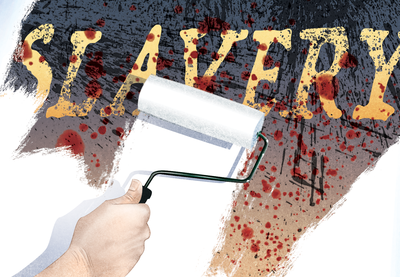In 2015, people looking for historical children’s literature might have found the New York Times review of the newly released title A Fine Dessert: Four Centuries, Four Families, One Delicious Treat—a review that praised the book’s “abundant charms.” A few months later, by the time the book appeared on the Times’ list of the “Best Illustrated Children’s Books of 2015,” more measured appraisals of the book had already begun to make news.
Central to criticism of the text was its portrayal of an enslaved woman and little girl on a South Carolina plantation. The book includes an illustration of enslaved people smiling as they pick blackberries and hiding in a closet to “lick the bowl clean” after serving dessert to their enslavers. One illustration incorporates words into a drawing of the little girl whisking cream: “Beat beat. Beat beat. Beat beat.”
Children’s books have the power to inspire and uplift. They can transform young readers. And because of this, they can be an ideal way for students to connect with and learn about history. But what do we do when authors misrepresent that history? What do we do when the stories get it wrong?
When and How Stories Fail Us
Authors of children’s books about slavery face a fundamental challenge: How do they depict characters who are enslaved—a condition defined by violence, deprivation, family separation and lifelong servitude—within a literary genre known for happy endings?
Ebony Elizabeth Thomas, an associate professor in University of Pennsylvania’s Graduate School of Education, has compiled a database of children’s books about slavery. Surveying more than 170 texts, Thomas and her researchers found that these books often misrepresent or even rewrite history—even if the author is well intentioned. And they do so in largely predictable ways.
One common choice, Thomas says, is to temper the lived experiences of enslaved characters. Often, the departure from history is dramatic. A Fine Dessert isn’t alone in its representation of #SlaveryWithASmile. Some books go so far as to erase enslaved characters entirely, focusing instead on celebrating white abolitionists or other accomplices.
During a 2018 talk at the Lapidus Center, Thomas discussed the wordless, illustrated children’s book Unspoken, A Story From the Underground Railroad. It’s about a white girl who assists a fugitive from slavery. This story about the Underground Railroad, Thomas points out, includes no representation of people who were actually enslaved.
But perhaps even more problematic is the question on the book’s back cover: “What would you do if you had the chance to help a person find freedom?” Asking readers to identify with white abolitionists rather than black or Native people escaping enslavement, the question is based on the assumption that most of the text’s readers will be white. Thomas says these ideas about the audience for children’s literature are pervasive throughout publishing.
Perhaps it’s this assumption that prevents publishers from recognizing the damage of popular, common stereotypes, like illustrations of smiling enslaved people, working cheerfully. Even when intended to humanize enslaved characters, Thomas says, these images could inadvertently send a troubling message: “that slavery wasn’t all that bad.”
When enslaved characters do make it into the spotlight, she explains, they’re often represented as “heroic or transcendent,” triumphing over slavery. Protagonists are fictional characters or real-life figures who escaped bondage, people like Harriet Tubman and Frederick Douglass, rather than one of the millions of people who were born and died enslaved.
John H. Bickford, a children’s literature scholar at Eastern Illinois University, agrees. He describes this as what some scholars call a pattern of exceptionalism. In his survey of more than 40 children’s books, he says, characters escaped or gained freedom “in every book save two.”
“This distortion ... cannot be overstated,” he wrote in a 2014 article, noting that escaping from enslavement was extremely dangerous and highly uncommon. “There’s a huge gap between what historians understand and trade book authors’ narratives.”
Thomas explains that this focus on freedom can send a dangerous message: “that no matter how traumatic and violent our collective national past might have been, the United States has always been a land of freedom, opportunity and equality under the law for everyone, if they just work hard enough.”
Many children’s books about slavery, she argues, are less about teaching children our nation’s history and more about “absolving the nation for what actually happened.” All too often, stories about slavery are framed within a false narrative of continuous racial progress and the enduring American Dream. Reaching for a happy ending, they leave the truth of slavery behind.
These stories have a reparative function—they must humanize and liberate. These stories must uplift, hope and heal while presenting the truth of slavery’s echoes in the present.
Learning From Misrepresentations
But even books that make these mistakes can be learning opportunities for secondary students, Bickford has found. He works with students to analyze the misrepresentations in children’s books, and this plays a role in helping students develop a more complete understanding of the history of American slavery.
The students read trade books, biographies and historical fiction written for younger readers. Bickford supplements these texts with maps, photographs, letters and other primary source materials—evidence that allows students to unmask the misrepresentations for themselves.
In one exercise, for example, he shares an excerpt from National Geographic’s Thomas Jefferson: “Whatever and whoever else he was, Thomas Jefferson helped light the torch [to liberty].”
“That’s how they’re contextualizing slavery,” Bickford says. “This was a book published in 2004.”
The book stresses Jefferson’s intellectual distaste for slavery and explains to readers that he never physically abused the people he enslaved. Bickford pairs the excerpt with two primary sources.
One is an ad placed by Jefferson, seeking the capture and return of someone who has escaped enslavement. The ad includes a description of the fugitive: He has scars and missing fingers, and he has been branded. The other is a letter in which Jefferson debates firing his overseer. He notes that the man is very good at his job. He also alludes to a bloodstain he saw below the whipping post at Monticello.
Once students have reviewed these primary sources, Bickford asks them to revise the original excerpts about Jefferson. Students are quick to see that “even if his hands weren’t bloody, he employed and kept the people who had the bloodiest hands.” In rewriting the passages, Bickford encourages students: “Keep what’s legit, but add some details, using footnotes or endnotes, or merely add into the narrative.”
By adjusting the scaffolding, the excerpts and the primary sources to the age group, younger students can use this technique, too, Bickford says. While it may take a little work to encourage elementary students to approach a picture book as a critical text, educators can walk them through close readings and comparative readings to help them better understand the arguments the text is making—and the information it’s leaving out.
Age is not the only identity consideration that should come into play for such classroom activities, however. In a 2016 article examining A Fine Dessert, Thomas and fellow experts Debbie Reese and Kathleen T. Horning pose questions for choosing and evaluating historical children’s texts that are also relevant here:

[W]ho will be reading the book? Is the imagined young reader of these historical stories a White, middle class, cisgender, heterosexual, able-bodied student who was born in the United States, or are child readers from all backgrounds being kept in mind? What kind of story is being told in the book? What makes the story difficult? Who is it difficult for? Does the nature of that difficulty differ depending on the demographic makeup of a classroom, school, or community?
These are questions educators should consider when thinking through related classroom exercises, as well.
Finding the Right Story
A critical analysis of a misleading text can give students the opportunity to recognize persistent myths around the history of American slavery—and the agency to correct those myths. But one thing it doesn’t offer is the opportunity for connection and immersion that well-crafted, historical children’s literature can provide.
Thomas maintains that there are children’s books that do offer a fair accounting of the history of American slavery. Educators just need to know how to find them. When choosing a book, she suggests, educators should carefully review the text and illustrations to consider the type of story that a book is telling—about enslaved characters, about the system of slavery and about the United States itself.
The first step is searching out texts that center the lives of enslaved people and resist stereotypes. While it may be tempting to choose a book that downplays the hardships of enslavement, Thomas argues against sugarcoating the lives of enslaved people. Adults, she says, should “present as much of the truth as the child can handle.”
Instead of sharing only stories in which protagonists escape, she says, educators can look for books with fully developed enslaved characters, characters who have desires and agency, who act for change, even if they don’t always achieve it.
And while the impulse toward a happy ending may lead authors toward a narrative of continuous racial progress, so that some stories about slavery end with the triumphs of the civil rights movement, Thomas encourages educators to be wary of books that contextualize slavery in this way.
Especially during this time of highly publicized police shootings, Black Lives Matter and an increase in racist rhetoric and violence, stories that misrepresent the truth can alienate students rather than connect them with the material. The narrative of “liberty and justice for all” can create “dissonance and disconnect,” Thomas says, especially among students of color, who may not recognize in the world around them the progress these stories imply.
One unavoidable challenge in selecting trade books is that the unvarnished facts of American slavery—the violence, brutality, family separations and multigenerational lifelong servitude that made the system itself possible—are traumatic for all children, but for black children in particular. Thomas explains that educators interested in using literature to teach children about slavery must be ready to consider “the psychological dimensions of enslavement as well as the collective trauma of black readers.”
Instead of contextualizing stories about slavery within a larger story of American racial progress, then, Thomas cites the work of anti-racist educators Louise Derman-Sparks and Julie Olsen Edwards. She recommends exposing students to a rich variety of books about black children and their families and a range of stories about black history, culture and life, from the past and the present.
When chosen carefully, children’s literature about slavery can do more than inform children about the past. “These stories have a reparative function—they must humanize and liberate,” Thomas says. “These stories must uplift, hope and heal while presenting the truth of slavery’s echoes in the present.”
Recommended Books That Address Slavery
Elementary Readers
• Love Twelve Miles Long by Glenda Armand, illustrated by Colin Bootman
• Dave the Potter: Artist, Poet, Slave by Laban Carrick Hill, illustrated by Bryan Collier
• Brick by Brick by Charles R. Smith, Jr., illustrated by Floyd Cooper
• Henry’s Freedom Box: A True Story From the Underground Railroad by Ellen Levine, illustrated by Kadir Nelson
Middle-level Readers
• Facing Frederick: The Life of Frederick Douglass, a Monumental American Man, by Tonya Bolden
• Africa Is My Home: A Child of the Amistad by Monica Edinger, illustrated by Robert Byrd
• The Glory Field by Walter Dean Myers
• Never Caught, the Story of Ona Judge by Erica Armstrong Dunbar and Kathleen Van Cleve
High School Readers
• Beloved by Toni Morrison
• 47 by Walter Mosley
• The Resurrection of Nat Turner (Parts 1 and 2) by Sharon Ewell Foster
Frank is a Hartford-based writer and co-author of Complicity: How the North Promoted, Prolonged, and Profited From Slavery.

Check out the toolkit for this story! The toolkit includes everything you need to put this story into action, including additional resources and recommendations to incorporate into your classroom.


1 COMMENTS